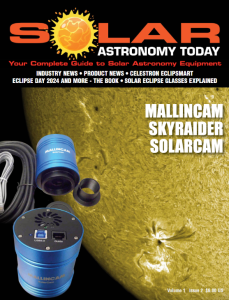The QHYCCD OAGL Pro uses a wider prism than the original QHYCCD OAGL to better accommodate larger sensor guide cameras. The prism size of the standard QHYOAG series is 8 x 8mm, while QHYOAGL Pro is 10 x 14mm.
 When using an off-axis guider (OAG), unlike external guiding solutions, the guiding camera and the imaging camera share the field of view of the main optical system. Telescopes with long focal lengths can often have fewer stars suitable for guiding within the field of view, especially under sub-ideal seeing conditions. One way to improve the chance of finding a decent guide star is to use a guide camera with a larger sensor and therefore, larger field of view.
When using an off-axis guider (OAG), unlike external guiding solutions, the guiding camera and the imaging camera share the field of view of the main optical system. Telescopes with long focal lengths can often have fewer stars suitable for guiding within the field of view, especially under sub-ideal seeing conditions. One way to improve the chance of finding a decent guide star is to use a guide camera with a larger sensor and therefore, larger field of view.
In order for these larger-sensor guide cameras to perform to their full potential in an off-axis guider, a prism large enough to allow illumination of the larger sensor is needed to avoid severe vignetting. And the new QHYCCD OAGL Pro version of the QHY Large Off-Axis Guider is designed to do just this.
The QHY OAG-L Pro attaches directly to the camera or filter wheel with six screws, ensuring a solid mechanical connection. Because the OAGL Pro is designed to support cameras with larger sensors (such as the QHY461PH and QHY600) and optical systems, the Pro only provides M62 and M54 thread outputs.
You can learn more about the QHYCCD OAGL Pro here.

 And to make it easier for you to get the most extensive news, articles and reviews that are only available in the magazine pages of Astronomy Technology Today, we are offering a 1-year magazine subscription for only $6! Or, for an even better deal, we are offering 2 years for only $9. Click here to get these deals which only will be available for a very limited time. You can also check out a free sample issue here.
And to make it easier for you to get the most extensive news, articles and reviews that are only available in the magazine pages of Astronomy Technology Today, we are offering a 1-year magazine subscription for only $6! Or, for an even better deal, we are offering 2 years for only $9. Click here to get these deals which only will be available for a very limited time. You can also check out a free sample issue here.
The Sun is more active than it’s been in years and if that’s not enough, we have the upcoming Total Solar Eclipse on April 8, 2024! If you’d like to learn more about the technology behind solar observing, solar imaging and more, you can check out our new monthly magazine – Solar Astronomy Today. It’s free to read, no subscription needed and available here. And if you are preparing for the upcoming eclipses and want to know your equipment options from solar glasses to the most out of this world solar viewing and imaging options, check out our free publication – The Definitive Guide to Viewing and Imaging the Sun – simply click here and enjoy reading!

